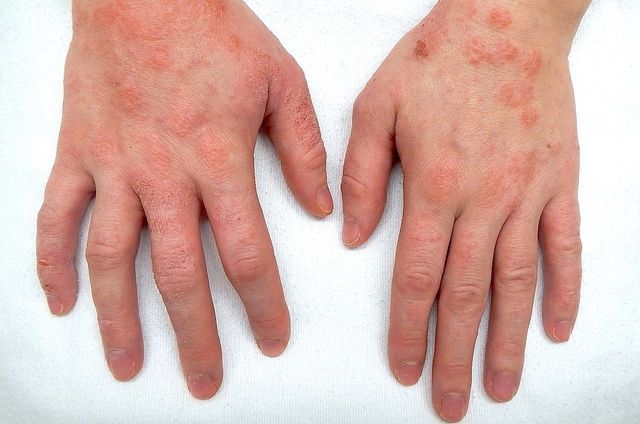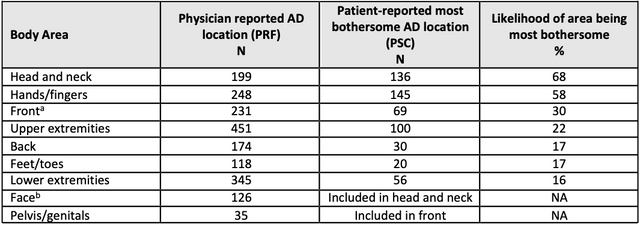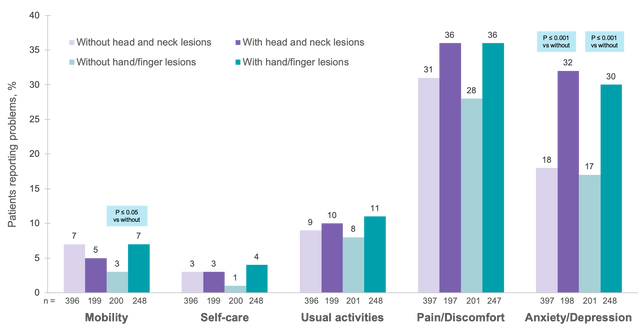
Effect of atopic dermatitis lesion location on quality of life: a real-world study
European Academy of Dermatology and Venereology Congress 2019
Atopic dermatitis (AD) is a chronic, heterogeneous and inflammatory skin disease. The symptoms, including itch, skin pain and sleep disturbances, can adversely affect quality of life in those suffering with the condition.
While numerous studies have demonstrated the negative impact of AD on quality of life, research typically focuses on quality of life in general or on disease severity and not the putative effects of AD lesion location. At the 28th Annual Congress of the European Academy of Dermatology and Venereology (EADV), held 9-13 October 2019 in Madrid, Spain, researchers presented the findings from an observational study investigating the impact of AD lesion distribution on quality of life in adults.1 In this week’s commentary, we present their findings.
Study design
The Adelphi Disease Specific Programme study was a retrospective, cross-sectional and observational study conducted from January to April 2018. The survey included physicians and matched adult (aged ≥18 years) patients with moderate-to-severe AD. Data collection involved the use of the patient record form (PRF) and patient self-completion (PSC) questionnaire. For the PRF, the physician completed the form for the patient with AD, noting:
- patient demographics and characteristics
- AD locations and body surface area (BSA) of lesion locations
For the PSC, patients reported the “most bothersome” AD location and patient-reported outcomes, including the Dermatology Life Quality Index (DLQI), Work Productivity and Activity Impairment (WPAI) questionnaire, EuroQol 5-Dimensions 3-level (EQ-5D-3L) questionnaire and EQ-5D visual analog scale (VAS).
Effect of atopic dermatitis lesion location on quality of life
Records were provided for 1054 patients by 150 physicians, of whom 599 completed a patient questionnaire. The mean age ± standard deviation (SD) was 38.9 ± 13.3, and 312 (52.1%) females participated. Among the patients, 254 (42.4%) had mild AD, 309 (51.6%) had moderate AD and 36 (6%) had severe AD. Results from the PRF and PSC analysis showed the areas likely to be most bothersome to patients were the head and neck and hands/fingers (Table). Only patients with data for both PRF and PSC were included in the analysis of areas likely to be most bothersome to patients.

Areas likely to be most bothersome to patients.
AD, atopic dermatitis; NA, not applicable; PRF, patient record form; PSC, patient self-completion questionnaire.
aFront included chest, abdomen, pelvis and genitals.
bFace included skin around the eyes and other areas of the face.
Patients with head and neck lesions and patients with hand/finger lesions were more likely to report anxiety/depression on the EQ-5D-3L compared to patients without these lesions (Figure). For patients with head and neck lesions, mobility, self-care, usual activities and pain/discomfort were similarly affected compared to those without. For patients with hand/finger lesions, self-care, usual activities and pain/discomfort were similarly affected relative to those without. While all lesion locations were shown to negatively affect patient quality of life, lesion location affected which quality of life measure (i.e. DLQI compared to EQ-5D-3L) was impacted.

Impact of specific atopic dermatitis lesion locations on the EQ-5D-3L.
This observational study identified a greater impact on quality of life and a greater potential for psychiatric symptoms (anxiety and depression) in AD patients with lesions on the head and neck and on the hands/fingers. The findings suggest that physicians should consider stepping up treatment for patients with lesions in these areas.
Action Eczema
To find out more about the effects of atopic dermatitis on patient quality of life and how to provide patient-centred care, explore our online CME courses:
To test your knowledge of holistic eczema treatment and management, try our ‘Self-assessment in atopic dermatitis’ and ‘Case challenge: 55-year-old woman with moderate-to-severe atopic dermatitis’ modules.
Interested in reading more about the AD research presented at EADV 2019? Sign up to Action Eczema and be notified when our EADV 2019 Congress Report is available online for viewing and CME credit.
References
- Lio P, Wollenberg A, Thyssen JP, et al. Impact of atopic dermatitis lesion location on quality of life in adult patients: results from a real-world study. Presented at the European Academy of Dermatology and Venerology (EADV) 2019. 9-13 October 2019; Madrid, Spain. Poster session.
Image source: James Heilman, MD